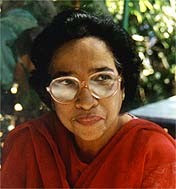
Hyderabad the “Pearl City of India” is a fascinating blend of past and present. Here cultures old and new coalesce into a colourful mosaic of architectural marvels, museums, parks and gardens, which transport the spell bound tourist from the forts and tombs of an elite Islamic past to Ramoji’s modern film city, from ancient purana havelis to the magnificent homes of the rich and famous on Jubilee Hills.
I searched in vain for the house where India’s nightingale was born. But like the mysterious veiled Rebecca in the Salar Jung Museum, Hyderabad has drawn a veil over her natal home.
“Sarojini Naidu ? Who?”
A blank look crossed the faces of those whom I asked, “Man, she must belong to Ancient history.”
Sarojini was born on the 13th of February, 1879 to Aghorinath Chattopadya a scientist, philosopher and educator, who founded the Nizam College, and a well known Bengali poetess Varadha Sundari Devi. Sarojini inherited the best genes of both her parents. She was something of a child prodigy, who passed her matriculation exam at the age of 13, and wrote a 1300 line poem on the Lady of the Lake in her early teens. She also wrote a play ‘Maher Muneer’ in Persian with some help from her father, which was well received in the literary world. The Nizam of Hyderabad was so impressed by her genius, that he offered her a scholarship to study abroad.
In 1895, at the age of 15, much against her will, she was sent to England. She studied at Kings College and Girton College Cambridge, rubbing shoulders with Arthur Symonds and Edmund Gausse. At this particular period in her life, she was influenced by the works of Tennyson, Shelley and Elizabeth Barret Browning, and her poems were western oriented. But Symonds and Gausse advised her to write on oriental themes – her own country, its mountains, rivers and people! She took their advice seriously. In her ‘Indian Love Song’ she wrote, “On ripe mango boughs of many coloured fruits, bright parrots cluster like vermilion flowers.” In her ‘Coromandel Fishers,’ she pictured “the wind asleep in the arms of dawn, like a child that has cried all night.”
Rich in imagery, her poems dealt with love and longing, separation and death. In ‘Ecstasy’ she talked of “the burden of love like the grace of a flower that is smitten with rain.”
Someone said that her poems had English words but an Indian soul.
Between 1905 and 1917, she published three volumes of poems – ‘The Golden Threshold,’ ‘Bird of Time,’ and ‘The Broken Wings,’ and won for herself the sobriquet “Nightingale of India.” Unfortunately today, her poems have been consigned to the archives. Modern poets call them “sentimental and mushy.” Others think they are “monotonous and boring.”
Poetry today has no rhyme or rhythm. Poems are mostly prose masquerading as poetry. No wonder Goethe said, “Modern poets mix too much water with their ink.”
Both Nehru and Tagore appreciated her poems.
Under the influence of Mahatma Gandhi, Sarojini channeled her energies into the Freedom Movement. When Gandhi was imprisoned in 1930, she took over the helm of the Movement. In 1931, she attended the Round Table Summit in London with Gandhi. Though she worked closely with him, she was never awed by his presence. In fact, she often teased him about his quirks. Many times she told him that the Freedom Movement lacked humour.
“May I confess privately that at odd intervals, I don’t feel very satyagrahic.”
She nicknamed Gandhi ‘Mickey Mouse’ and called him ‘My Little Man’ or ‘My Mystic Spinner.’ She never failed to remind him that it cost the exchequer a packet to keep him poor.
When Sarojini was sent to South Africa to encourage the Indians to fight against oppression, she wrote to Gandhi, “I cannot sleep in South Africa and its all your fault.”
Sarojini moved with politicians like Nehru, Gokhale, Malaviya and even Jinnah, whom she called ‘Ambassador of Hindu-Muslim Unity.’ Whether joining Gandhi in the Dandi March or participating in the movement against the Rowlett Act, she made her presence felt. In 1942, she was arrested during the Quit India Movement and was imprisoned for several months.
Sarojini was a feminist to the core. Her first defiance of tradition came at the age of 19, when she married a South Indian doctor Govindarajulu Naidu. It was an unacceptable union, as the doctor was a non-Brahmin. They married in 1898 under the Brahmo Samaj Act. This was a happy union, and she bore him four daughters.
Sarojini travelled extensively all over India giving lectures to youth on Dignity of labour, and Women’s Emancipation. She brought women out of their kitchens and championed their rights. She encouraged them to participate in politics. She wanted every woman to be aware of her self worth.
“We want a new breed of men before India can be cleansed of her diseases.”
“We want a deeper sincerity of motive, a greater courage in speech and earnestness in action.”
Oh how the modern day feminists would have embraced her!
Sarojini was the founder of the “Women’s India Association” and worked closely with Annie Besant and Margaret Cousins. She became the first governor of U.P. and died in Lucknow at the age of 70, on 2nd March 1949. On her 61st Death Anniversary, one recalls Nehru’s eulogy to the Nightingale of India.
“Here was a person of great brilliance…….a person vital and vivid…….of so many gifts, some of which made her unique. She infused artistry and poetry into the national struggle.”
One can only salute her indomitable spirit and her capacity to face difficulties “with a light heart and a song on her lips.”






